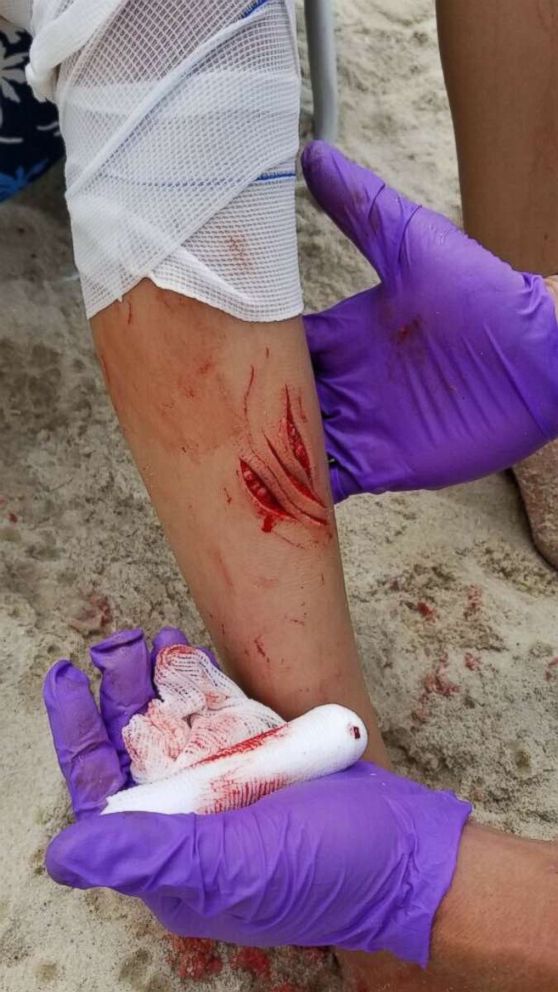13-year-old boy bitten by possible shark off Fire Island, authorities investigating a second suspected attack
One of the two was bitten off Sailor Haven, and the other at Atlantique Beach.
Authorities are investigating whether a 13-year-old boy and a 12-year-old girl who both suffered large fish bites in the waters off of Fire Island were victims of shark attacks.
Shortly before noon today, officials said, the girl was bitten while wading in the water at a beach known as Sailors Haven on Fire Island, a barrier beach off the south shore of Long Island.
The girl's mother, Barbara Pollina, told ABC News that her daughter Lola is "hanging in there - a little overwhelmed right now."
Soon after that attack, the boy was bitten while boogie boarding in the waters off another Fire Island beach, known as Atlantique, officials said. The two beaches are several miles apart.
Emergency medical workers removed a suspected shark tooth from the unidentified boy's leg, which suffered a puncture wound, according to officials with the Long Island town of Islip. The tooth is now being analyzed to determine the source of the attack.
“Both of these young kids, thank God, are okay,” Islip Town Supervisor Angie Carpenter said at a press conference on Wednesday afternoon.

Carpenter said that the boy was bitten after a wave knocked him off his boogie board. Lifeguard Bella Cohen took the boy to a tent and dressed his wound. That's when the puncture wounds were discovered, Carpenter said.
The boy was transported by police boat to a local hospital, she said.
Dueling responses from different officials midday left some confusion as to what had attacked the two young people.
Islip town officials initially confirmed that the boy's bite was indeed a shark attack, but later issued a statement saying that the 13-year-old was bit by "what may possibly have been a shark."
"It has not been totally confirmed" that the boy was bitten by a shark, Carpenter said, but lifeguards and emergency medical personnel who treated the victim assumed it was a shark bite when they found the shark tooth in his leg.

Neither Suffolk County nor the National Parks Service -- which oversees some of Fire Island's beaches -- have yet confirmed that either of the bites came from sharks. County officials said that while the bite appeared to be from a shark, there had so far been no shark sighting.
A National Parks Service official told ABC News that the designation of a shark attack must come from the New York State Department of Environmental Conservation.
Lola's father, Philip Pollina, said he could tell what he was seeing when he looked at her wound.
“I think it was a shark attack," he said at a press conference. “When I saw the bite, there was a bite on her leg, there was no question what it was.”
His daughter, who concurred with her father's assessment, said she had come through the incident intact.
“I thought it was a shark," the 12-year-old said at the press conference. "We were at the beach and there wasn’t a tiger or anything,” she said, laughing.
The youngster was wading in waist-deep water when she spotted what appeared to her to be a three to four-foot shark.
"When I first got bit, I couldn’t feel it, so it didn’t hurt that bad."
It was only after lifeguards began pouring water on the wound and wrapping it in gauze that she began to wince.
Beaches within the Town of Islip and all Fire Island National Seashore beaches are closed for at least the day in the wake of the attack.

Further west and a few hours after the two attacks, bathers were evacuated from the waters off Robert Moses State Park and Jones Beach after a lifeguard spotted a shark.
State police sent a drone into the air to search the waters for sharks, according to George Gorman, Long Island deputy regional director of the state Office of Parks, Recreation and Historic Preservation.
Bathers were allowed to return to the water after the lifeguard sighting was confirmed to be a sandbar shark. Sandbar sharks are considered to be a relatively benign type of shark, which feed on fish, crabs and stingrays -- and are not known for attacking humans.
Carpenter, the Islip town supervisor, said a midsummer reminder was in order for south shore beachgoers.
"We’re seeing this as an opportunity to remind everyone that the water is beautiful -- its magnificent here on the south shore of Long Island, but treacherous."
"So you need to be careful at all times."
One shark expert said that bites were definitely from a shark.
George Burgess, director of the International Shark Attack File maintained by the Florida Museum of Natural History, told ABC News that the bites were "definitely" from a shark.
Burgess said that the size and shape of the bites, and the tooth embedded in one victim's leg, indicate that the shark is either a small shark of a larger species, or a species small in size.
He said it was unlikely that it was a great white shark, because such a shark would likely have caused far more grievous injuries, and the victims may not have been able to walk around afterwards.
He said, however, that he would need to look at a better picture of the tooth to be able to make any definite assessments.
The attacks come just days before the July 22 start of Discovery Channel's annual "Shark Week" programming marathon, now in its 30th year.




